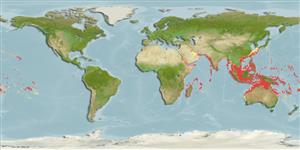>
Eupercaria/misc (Various families in series Eupercaria) >
Lutjanidae (Snappers) > Lutjaninae
Etymology: Lutjanus: Malay, ikan lutjan, name of a fish.
More on author: Forsskål.
Environment: milieu / climate zone / depth range / distribution range
ນິເວດວິທະຍາ
ສັດທະເລ ກ່ຽວກັນຫີນ; ລະດັບຄວາມເລິກ 1 - 150 m (Ref. 9710). Tropical; 35°N - 33°S, 31°E - 134°W (Ref. 55)
Indo-Pacific: Red Sea and East Africa to the Line and Society islands, north to southern Japan, south to Australia.
Length at first maturity / ຂະໜາດ / ນ້ຳໜັກ / Age
Maturity: Lm 21.5 range ? - ? cm
Max length : 56.8 cm FL ຕົວຜູ້/ບໍ່ມີເພດ; (Ref. 125599); common length : 45.0 cm TL ຕົວຜູ້/ບໍ່ມີເພດ; (Ref. 5450); ນ້ຳໜັກສູງສຸດທີ່ເຄຍຈັດພີມມາ: 2.8 kg (Ref. 125599); ອາຍຸສູງສຸດທີ່ເຄຍລາຍງານມາ: 18 ປີ (Ref. 2293)
ຄີ (ໜາມ)ແຂງຢູ່ຫຼັງປາ (ທັງໝົດ): 10; ຄີຫຼັງຂອງປາ (ຄີອ່ອນ) (ທັງໝົດ): 13-14; ຄີ(ໜາມ) ແຂງຢູ່ຄີກົ້ນປາ
ກຸ່ມປາກະດູກແຂງ
ຄວາມຖີ່ຂອງກຸ່ມຖ່າຍທອດພັນ
ປາທີ່ມີການເຄື່ອນຍ້າຍຈາກທະເລໄປຫານ້ຳຈືດ ແລະນ້ຳຈືດຫາທະເລ
ປາທີ່ມີການເຄື່ອນຍ້າຍຈາກທະເລແລະໄປໄຂ່ຢູ່ນ້ຳຈືດ
ຄີກົ້ນຂອງປາ
ສັດທີ່ມີກະດູກສັນຫັຼງ
ການຖ່າຍທອດທາງກຳມະພັນຈາກພໍ່ແມ່ຫາລູກ 3; ຄີກົ້ນຂອງປາ: 8. This species is distinguished by the following characters: body moderately deep; greatest depth 2.2-2.5 in SL; preopercular notch and knob well developed; vomerine tooth patch crescentic, without a medial posterior extension; gill rakers of first gill arch 9-10 + 115-20 = 25-30 (including rudiments); caudal fin distinctly forked with rounded lobes. Colour red to greyish, an orange hue on lower part of opercle and in pectoral fin axil; fins red (pectoral fins) or usually dark brown to blackish; soft part of dorsal fin, anal and caudal fins with a narrow white margin; juveniles with a large round black spot at base of caudal fin (Ref. 9821, 90102).
Adults mainly inhabit coral reefs, sometimes forming large aggregations, which are mostly stationary during the day. Juveniles occur in seagrass beds, also in mixed sand and coral habitats of shallow sheltered reefs (Ref. 1602). Sub-adults commonly form very large schools that are stationary or drift slowly along slopes during the day. Large individuals along coastal slopes at moderate depths (Ref. 48635). Benthopelagic (Ref. 58302). Feed on fishes, and a variety of invertebrates including shrimps, crabs, lobsters, stomatopods, cephalopods, echinoderms and ophiuroids (Ref. 55). Caught mainly with handlines, traps, and gill nets. Commonly sold fresh. Sometimes causes ciguatera poisoning, particularly around the Pacific islands (Ref. 9821).
Off East Africa spawning occurs mainly during spring and summer.
Allen, G.R., 1985. FAO Species Catalogue. Vol. 6. Snappers of the world. An annotated and illustrated catalogue of lutjanid species known to date. FAO Fish. Synop. 125(6):208 p. Rome: FAO. (Ref. 55)
IUCN Red List Status (Ref. 130435)
Threat to humans
Reports of ciguatera poisoning (Ref. 9710)
Human uses
ການປະມົງ: ເປັນສີນຄ້າ; ຊະນິດປາທີ່ຖືກນຳໃຊ້ເຂົ້າໃນການຫາເພື່ອເປັນເກມກິລາ: ແມ່ນ; ຕູ້ປາ: ບ່ອນວາງສະແດງສັນນ້ຳຂອງລັດ
ຂໍ້ມູນຕື່ມອີກ
ເອກະສານອ້າງອີງການລ້ຽງສັດນ້ຳຂໍ້ມູນການລ້ຽງສັດນ້ຳສາຍພັນກຳມະພັນElectrophoresesການຖ່າຍທອດທາງກຳມະພັນຈາກພໍ່ແມ່ຫາລູກພະຍາດການປຸງແຕ່ງNutrientsMass conversion
ເຄື່ອງມື
Special reports
Download XML
ແຫຼ່ງອີນເຕີເນັດ
Estimates based on models
Preferred temperature (Ref.
123201): 24.5 - 29.1, mean 28 °C (based on 2228 cells).
Phylogenetic diversity index (Ref.
82804): PD
50 = 0.5000 [Uniqueness, from 0.5 = low to 2.0 = high].
Bayesian length-weight: a=0.01549 (0.01389 - 0.01727), b=2.97 (2.95 - 2.99), in cm total length, based on LWR estimates for this species (Ref.
93245).
ຊັ້ນເຂດຮ້ອນ (Ref.
69278): 4.1 ±0.3 se; based on diet studies.
ຄວາມຢືດຢຸ່ນ (Ref.
120179): ຂະໜາດກາງ, ປະຊາກອນຕຳ່ສຸດທີ່ໃຊ້ເວລາສອງເທົ່າ 1.4 - 4.4 ປີ (K=0.31-0.40; tmax=18).
Prior r = 0.57, 95% CL = 0.37 - 0.85, Based on 1 stock assessment.
Fishing Vulnerability (Ref.
59153): Moderate vulnerability (36 of 100).
Climate Vulnerability (Ref.
125649): High vulnerability (63 of 100).
Nutrients (Ref.
124155): Calcium = 31.8 [20.8, 43.7] mg/100g; Iron = 0.323 [0.211, 0.482] mg/100g; Protein = 18.6 [17.1, 19.9] %; Omega3 = 0.148 [0.108, 0.199] g/100g; Selenium = 72.2 [50.0, 100.4] μg/100g; VitaminA = 137 [26, 492] μg/100g; Zinc = 0.406 [0.333, 0.555] mg/100g (wet weight); based on
nutrient studies.
